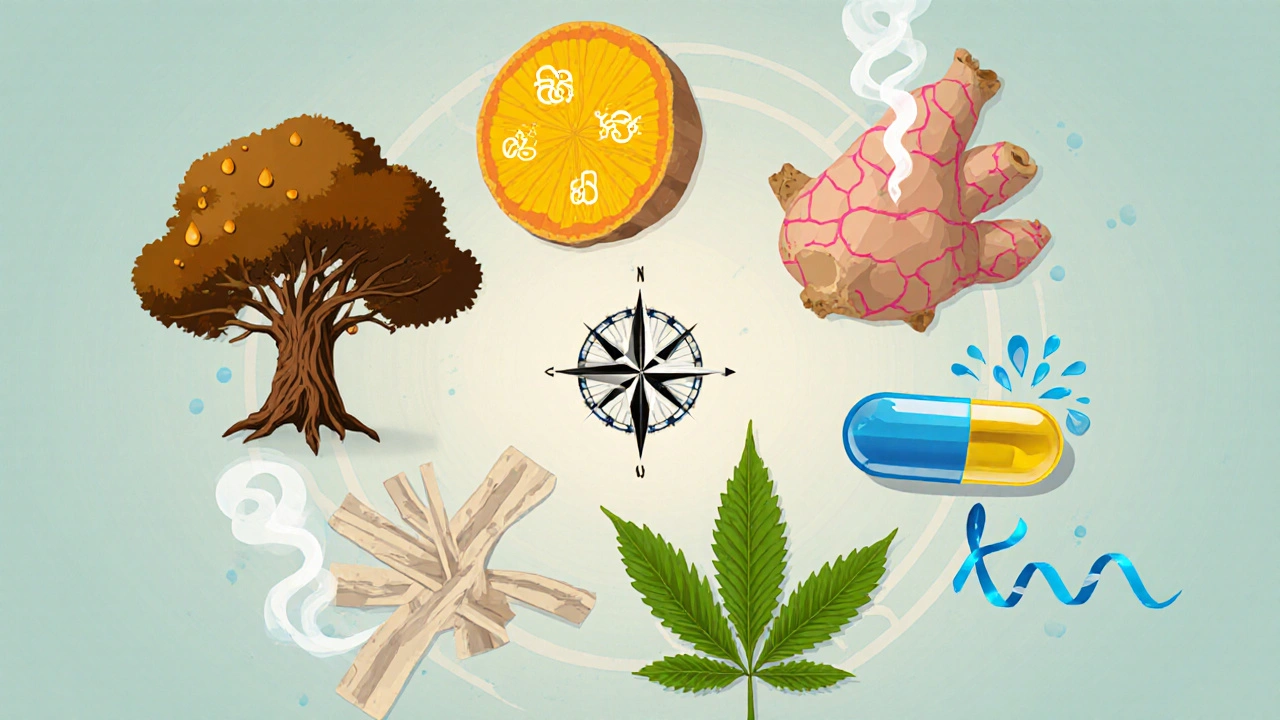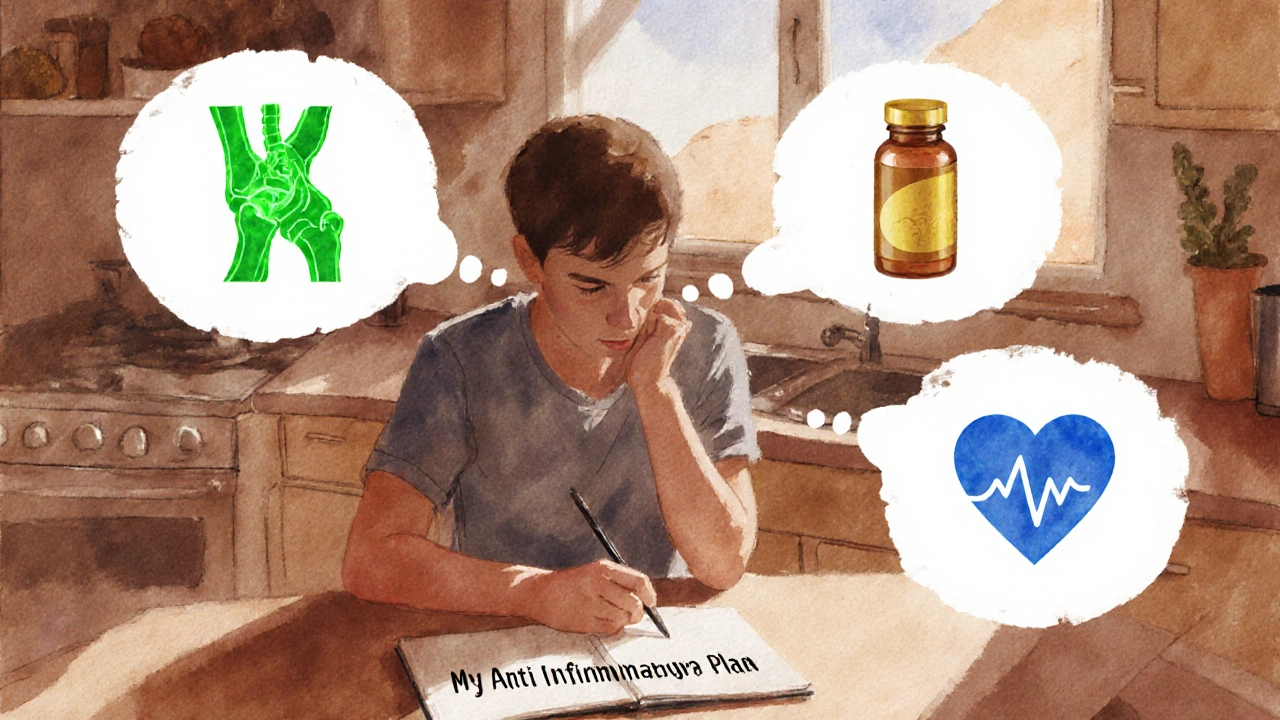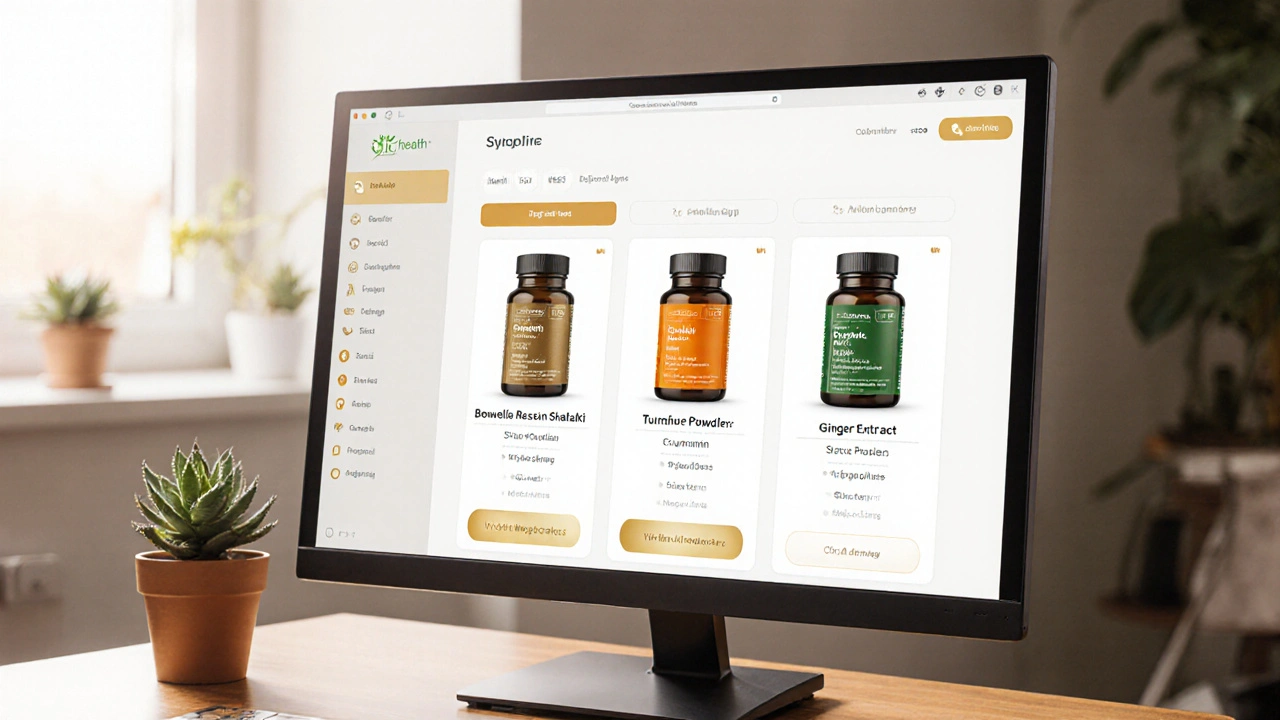Natural Anti-Inflammatory Supplement Comparison Tool
Recommended Supplements for Your Concern
Shallaki (Boswellic Acid)
Mechanism: 5-LOX inhibition
Evidence Level: Moderate (5 RCTs)
Typical Dose: 300-500 mg 2-3×/day
Safety Concerns: Minor GI upset
Cost: $0.90-$1.35/day
Curcumin (Turmeric)
Mechanism: NF-κB & COX-2 blockade
Evidence Level: Strong (200+ RCTs)
Typical Dose: 500-1000 mg with piperine
Safety Concerns: Stomach upset at high dose
Cost: $0.60-$1.05/day
Gingerol (Ginger)
Mechanism: Prostaglandin inhibition
Evidence Level: Moderate (10+ RCTs)
Typical Dose: 250-500 mg 2-3×/day
Safety Concerns: Blood-thinning
Cost: $0.45-$0.75/day
Salicin (White Willow Bark)
Mechanism: Salicylic acid conversion
Evidence Level: Moderate (20+ RCTs)
Typical Dose: 60-240 mg 2-3×/day
Safety Concerns: Stomach irritation
Cost: $0.30-$0.60/day
CBD Oil
Mechanism: Endocannabinoid modulation
Evidence Level: Emerging (small RCTs)
Typical Dose: 15-30 mg daily
Safety Concerns: Dry mouth, drowsiness
Cost: $0.75-$1.50/day
Omega-3 (EPA/DHA)
Mechanism: Eicosanoid balance
Evidence Level: Strong (meta-analyses)
Typical Dose: 1-3 g daily
Safety Concerns: Clotting risk at high dose
Cost: $0.90-$2.10/day
Low-Dose Aspirin
Mechanism: COX-1/2 irreversible inhibition
Evidence Level: Very strong (century-long data)
Typical Dose: 81 mg daily
Safety Concerns: Bleeding, stomach ulcer
Cost: $0.02/day
When you search for a natural way to curb inflammation, Shallaki often pops up alongside a crowd of other botanicals. But which option actually delivers the results you want, and at what price? This guide breaks down the science, safety, and cost of Shallaki (boswellic acid) and its most common rivals, so you can pick the one that fits your health goals without guessing.
Quick Take
- Shallaki (boswellic acid) offers moderate anti‑inflammatory power with strong gut safety.
- Curcumin (turmeric) is the most researched but needs enhanced absorption.
- Gingerol (ginger) is great for nausea and mild inflammation.
- Salicin (white willow bark) works like low‑dose aspirin but can irritate the stomach.
- CBD, Omega‑3, and low‑dose aspirin each have unique strengths; choose based on your main symptom.
What Is Shallaki (Boswellic Acid)?
Shallaki is a resin extracted from the Boswellia serrata tree, native to India and the Arabian Peninsula. The active compounds, collectively called boswellic acids, inhibit 5‑lipoxygenase (5‑LOX), a key enzyme in leukotriene production, which reduces inflammatory signaling.
Key attributes:
- Typical dosage: 300‑500mg of standardized extract (≥65% boswellic acids) 2-3 times daily.
- Evidence level: Multiple randomized controlled trials (RCTs) show benefit for osteoarthritis pain and inflammatory bowel disease.
- Safety profile: Generally well‑tolerated; occasional minor GI upset.
- Cost: Mid‑range - US$0.30‑0.45 per 500mg capsule.
Top Natural Alternatives
Below are the most popular botanicals people compare with Shallaki. Each entry follows the same attribute pattern so you can stack them side‑by‑side later.
Curcumin (Turmeric)
Curcumin is the bright yellow polyphenol in Curcuma longa (turmeric). It blocks NF‑κB and COX‑2 pathways, delivering broad‑spectrum anti‑inflammation.
- Typical dosage: 500‑1000mg of standardized extract (95% curcuminoids) with piperine for absorption.
- Evidence level: Extensive - over 200 RCTs for arthritis, metabolic syndrome, and cancer adjunct therapy.
- Safety profile: Safe; high doses may cause occasional stomach upset.
- Cost: Low‑to‑mid - US$0.20‑0.35 per 500mg capsule.
Gingerol (Ginger)
Gingerol is the primary active component of fresh Zingiber officinale (ginger). It inhibits prostaglandin synthesis and has antioxidant activity.
- Typical dosage: 250‑500mg of ginger extract (5% gingerols) 2-3 times daily.
- Evidence level: Moderate - several RCTs show relief for osteoarthritis and menstrual pain.
- Safety profile: Very good; may thin blood at high doses.
- Cost: Low - US$0.15‑0.25 per 250mg capsule.
Salicin (White Willow Bark)
Salicin is a natural phenolic glycoside found in Salix alba (white willow bark). Once ingested, it converts to salicylic acid, the precursor of aspirin.
- Typical dosage: 60‑240mg of salicin (roughly equivalent to 81‑325mg aspirin) 2-3 times daily.
- Evidence level: Moderate - classic studies show analgesic effect comparable to low‑dose aspirin.
- Safety profile: Can irritate stomach lining; avoid if you have ulcer history.
- Cost: Low - US$0.10‑0.20 per 100mg salicin tablet.
CBD Oil
CBD (cannabidiol) is a non‑psychoactive cannabinoid extracted from Cannabis sativa flowers. It modulates the endocannabinoid system, dampening inflammatory cytokines.
- Typical dosage: 15‑30mg daily, often as a tincture.
- Evidence level: Emerging - small RCTs suggest benefit for arthritis pain and anxiety.
- Safety profile: Excellent; mild dry mouth, drowsiness at high doses.
- Cost: Mid‑to‑high - US$0.25‑0.50 per 10mg CBD.
Omega‑3 (EPA/DHA)
Omega‑3 fatty acids (eicosapentaenoic acid - EPA, and docosahexaenoic acid - DHA) are long‑chain polyunsaturated fats from fish oil or algae.
- Typical dosage: 1‑3g combined EPA/DHA per day.
- Evidence level: Strong - meta‑analyses link omega‑3s to reduced joint swelling and cardiovascular inflammation.
- Safety profile: Very good; high doses may affect clotting.
- Cost: Variable - US$0.30‑0.70 per 1g capsule.
Low‑Dose Aspirin (Acetylsalicylic Acid)
Aspirin is a synthetic derivative of salicylic acid that irreversibly inhibits COX‑1 and COX‑2 enzymes.
- Typical dosage: 81mg daily for cardiovascular protection; 325‑650mg for pain.
- Evidence level: Very strong - decades of data for pain, fever, and platelet inhibition.
- Safety profile: Can cause gastric irritation, bleeding risk at higher doses.
- Cost: Very low - US$0.02 per 81mg tablet.

Side‑by‑Side Comparison
| Ingredient | Primary Mechanism | Evidence Strength | Typical Dose | Safety Concerns | Average Cost (US$/day) |
|---|---|---|---|---|---|
| Shallaki (Boswellic Acid) | 5‑LOX inhibition | Moderate (5 RCTs) | 300‑500mg 2‑3×/day | Minor GI upset | 0.90‑1.35 |
| Curcumin | NF‑κB & COX‑2 blockade | Strong (200+ RCTs) | 500‑1000mg with piperine | Stomach upset at high dose | 0.60‑1.05 |
| Gingerol | Prostaglandin inhibition | Moderate (10+ RCTs) | 250‑500mg 2‑3×/day | Blood‑thinning | 0.45‑0.75 |
| Salicin (White Willow) | Salicylic acid conversion | Moderate (20+ RCTs) | 60‑240mg 2‑3×/day | Stomach irritation | 0.30‑0.60 |
| CBD | Endocannabinoid modulation | Emerging (small RCTs) | 15‑30mg daily | Dry mouth, drowsiness | 0.75‑1.50 |
| Omega‑3 (EPA/DHA) | Eicosanoid balance | Strong (meta‑analyses) | 1‑3g daily | Clotting risk at high dose | 0.90‑2.10 |
| Aspirin (81mg) | COX‑1/2 irreversible inhibition | Very strong (century‑long data) | 81mg daily | Bleeding, stomach ulcer | 0.02 |
Which One Fits Your Goal?
Now that the numbers are laid out, match the ingredient to your primary concern.
- Joint pain & osteoarthritis: Curcumin or Omega‑3 rank highest for evidence; if you prefer a resin, choose Shallaki.
- Digestive inflammation (IBD, gastritis): Shallaki shows the most consistent benefit in gut studies, followed by low‑dose aspirin (under medical supervision).
- Acute muscle soreness or menstrual cramps: Gingerol works fast and is easy on the stomach.
- Blood‑thinning needs: Avoid high‑dose ginger and aspirin; CBD offers mild anticoagulant effect without major GI risk.
- Budget‑conscious: Salicin and aspirin are cheapest; however, consider long‑term GI safety.
How to Pick the Right Supplement
Use this mini‑decision tree to avoid common pitfalls:
- Identify your main symptom (joint, gut, muscle, overall inflammation).
- Check any existing medication - especially blood thinners or NSAIDs.
- Match the symptom to the ingredient with the strongest evidence (see table).
- Consider dosage convenience - capsules vs. liquid vs. powder.
- Factor in cost per day and any known allergies.
- Start with the lowest effective dose and monitor side effects for 2‑4 weeks.
If you’re uncertain, a quick chat with a pharmacist or dietitian can narrow the choice further.
Potential Pitfalls & How to Avoid Them
- Assuming all “natural” equals safe: Salicin can cause ulcers; high‑dose ginger can interact with warfarin.
- Skipping absorption enhancers: Curcumin needs piperine or a phospholipid carrier; otherwise bioavailability is <10%.
- Ignoring product quality: Look for third‑party testing (e.g., USP, NSF) for contaminants and accurate boswellic acid content.
- Mixing multiple anti‑inflammatories: Combining Shallaki, aspirin, and high‑dose ginger may increase bleeding risk.

Frequently Asked Questions
Is Shallaki safe for long‑term use?
Yes, most studies report good tolerance for up to 12months when taken at the recommended dose. The main side effect is mild stomach discomfort, which can be mitigated by taking the capsule with food.
How does boswellic acid differ from curcumin?
Boswellic acid blocks the 5‑LOX pathway, while curcumin targets NF‑κB and COX‑2. This means Shallaki may be more effective for leukotriene‑driven inflammation (e.g., asthma, gut inflammation), whereas curcumin excels in broader systemic inflammation.
Can I combine Shallaki with omega‑3s?
Absolutely. They work via different mechanisms and there’s no known interaction. In fact, many clinicians recommend a combo of a resin (Shallaki) plus omega‑3s for joint health.
What’s the best way to boost curcumin absorption?
Add a pinch of black‑pepper extract (piperine) or choose a curcumin‑phosphatidylcholine (Meriva) formulation. Both increase bioavailability by 10‑20 fold.
Should I avoid Shallaki if I’m on blood thinners?
Current evidence suggests a low bleeding risk, but it’s wise to check with your physician because any anti‑inflammatory can slightly affect platelet function.
Armed with the facts, you can now decide whether Shallaki’s resin power wins over turmeric’s bright profile, ginger’s zing, or any of the other natural options. Remember, the best supplement is the one that matches your specific need, fits your budget, and feels safe for you.

Thomas Burke
If you’re hunting for a gut‑friendly anti‑inflammatory, Shallaki’s low GI upset profile makes it a solid starter – just pair it with a fatty meal for better absorption.
Debbie Frapp
The table does a good job laying out dosing ranges, but remember that bioavailability matters – curcumin without piperine or a phospholipid carrier sits at the bottom of the absorption curve. A modest dose of a standardised Boswellia extract can hit therapeutic plasma levels without the extra cost of absorption enhancers. Also, keep an eye on any concurrent NSAID use; overlapping pathways could increase GI irritation. Overall, matching the supplement to your primary symptom while watching for drug‑supplement interactions is the safest strategy.
Michelle Abbott
From a mechanistic standpoint, the 5‑LOX inhibition offered by boswellic acids is pharmacodynamically subordinate to the NF‑κB blockade of curcumin, rendering Shallaki a sub‑optimal candidate in the hierarchy of signal transduction modulators. Moreover, the paucity of high‑resolution pharmacokinetic data undermines its translational robustness. In the absence of rigorous dose‑response curves, the empiric efficacy remains marginal at best. Bottom line: the evidence tier does not justify prioritising Shallaki over more extensively validated phytochemicals.
Heather Jackson
Wow, reading that table felt like watching a showdown in the Wild West – each herb stepping up like a gunslinger with its own trick. Shallaki may not have the flashiest price tag, but its gut‑friendly rep is kinda like the quiet hero that folks often overlook. If you’re looking for something that won’t terrorize your stomach, that resin might just be the knight in shining bark. Definitely worth a shot before splurging on the pricey “miracle” powders. (And yes, “definately” not “definitely” – sorry, typo made it real.)
Akshay Pure
One must acknowledge that the intellectual rigor applied to curcumin research eclipses the modest investigations surrounding Boswellia extracts. The sheer volume of meta‑analyses for omega‑3s elevates them to a near‑canonical status within evidence‑based nutraceuticals. While Shallaki presents a tolerable safety profile, its moderate efficacy ranks merely as an adjunct rather than a primary therapeutic agent. In scholarly discourse, we reserve first‑line recommendations for compounds with both depth of data and mechanistic clarity.
Steven Macy
When contemplating the labyrinth of natural anti‑inflammatory agents, it helps to adopt a systems‑thinking perspective rather than focusing on isolated pathways. Shallaki’s inhibition of 5‑LOX offers a targeted reduction in leukotriene synthesis, which can be particularly advantageous for patients whose symptoms are driven by leukotriene‑mediated mechanisms. Yet, the human body is an intricate network where NF‑κB, COX‑2, and prostaglandin cascades intersect, meaning that a single‑node intervention may only partially alleviate the inflammatory milieu. Curcumin, by contrast, exerts a pleiotropic effect, dampening NF‑κB, COX‑2, and various cytokines, which explains its robust evidence base across diverse disease states. The trade‑off, however, resides in its notoriously poor bioavailability, a hurdle that can be mitigated with piperine or lipid formulations but at the cost of added complexity. Gingerol presents a middle ground, offering prostaglandin inhibition with a gentle safety profile, yet its blood‑thinning propensity necessitates caution in individuals on anticoagulants. Salicin’s conversion to salicylic acid mirrors low‑dose aspirin, delivering reliable analgesia but bearing the classic risk of gastric irritation, especially when taken without food. Omega‑3 fatty acids modulate eicosanoid pathways, providing a downstream balance that can complement other agents, though high doses may tip the hemostatic equilibrium. CBD’s endocannabinoid modulation introduces a novel mechanism that appears synergistic with traditional anti‑inflammatories, but the current evidence remains nascent and regulatory landscapes are still evolving. From a pragmatic standpoint, the choice of supplement should align with the patient’s primary symptom, comorbid conditions, and financial considerations. For gut‑centric inflammation, the modest evidence supporting Boswellia’s efficacy in IBD suggests a reasonable first‑line natural option, provided the individual tolerates the capsule form. In joint pathology, the weight of RCTs leans heavily toward curcumin and omega‑3s, making them preferable when cost is not prohibitive. Ultimately, an incremental approach-starting with a low dose of the chosen agent, monitoring response for a month, and then adjusting or combining with another supplement-embodies the principle of personalized, evidence‑informed care. By respecting the nuances of each molecule’s mechanism, safety, and evidence tier, clinicians and patients can navigate the supplement landscape with confidence and clarity. Consistent documentation of outcomes will also facilitate future research and guide community recommendations.
Joanne Myers
The comparative matrix succinctly highlights cost differentials while preserving clinical relevance. Notably, Boswellia’s mid‑range pricing aligns with its moderate evidence rating. Such transparency assists practitioners in evidence‑based prescribing.
rahul s
Listen, our ancient Ayurvedic wisdom has out‑performed many Western “synthetic” fixes, and Shallaki is a testament to that heritage. While some cheerleader‑type marketers push pricey fish oils, the truth is that the Indian subcontinent birthed a resin that can calm inflammation without draining your wallet. Don’t be fooled by the glossy packaging of foreign brands; home‑grown boswellic acid packs a punch that rivals any imported marvel. Embrace the local powerhouse and let the rest chase shadows.
Julie Sook-Man Chan
Sounds like a solid plan.
Amanda Mooney
In summary, aligning supplement choice with specific inflammatory pathways optimizes therapeutic outcomes. This structured approach fosters both efficacy and safety.